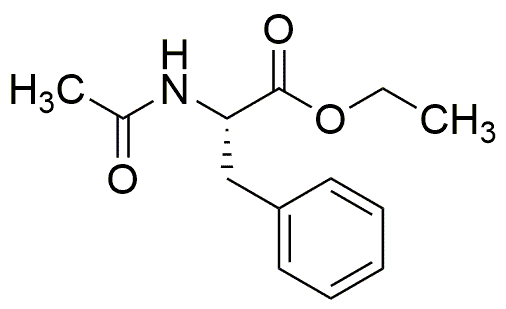Acetyl-L-phenylalanine ethyl ester is widely utilized in research focused on:
- Pharmaceutical Development: This compound serves as a building block in the synthesis of various pharmaceuticals, particularly in the development of peptide-based drugs that target specific biological pathways.
- Neuroscience Research: It is used in studies investigating neurotransmitter functions and neuroprotective effects, helping researchers understand conditions like Alzheimer's and Parkinson's disease.
- Biotechnology: In the field of biotechnology, it aids in the production of modified proteins and enzymes, enhancing their stability and activity for industrial applications.
- Cosmetic Formulations: The compound is incorporated into skincare products for its potential anti-aging properties, providing benefits such as improved skin hydration and elasticity.
- Food Industry: It is explored as a flavoring agent or additive, contributing to the enhancement of taste profiles in various food products.
Informations générales
Propriétés
Sécurité et réglementation
Applications
Acetyl-L-phenylalanine ethyl ester is widely utilized in research focused on:
- Pharmaceutical Development: This compound serves as a building block in the synthesis of various pharmaceuticals, particularly in the development of peptide-based drugs that target specific biological pathways.
- Neuroscience Research: It is used in studies investigating neurotransmitter functions and neuroprotective effects, helping researchers understand conditions like Alzheimer's and Parkinson's disease.
- Biotechnology: In the field of biotechnology, it aids in the production of modified proteins and enzymes, enhancing their stability and activity for industrial applications.
- Cosmetic Formulations: The compound is incorporated into skincare products for its potential anti-aging properties, providing benefits such as improved skin hydration and elasticity.
- Food Industry: It is explored as a flavoring agent or additive, contributing to the enhancement of taste profiles in various food products.
Documents
Fiches de données de sécurité (FDS)
La FDS fournit des informations de sécurité complètes sur la manipulation, le stockage et l’élimination du produit.
Spécifications du produit (PS)
Le PS fournit une description complète des propriétés du produit, notamment sa composition chimique, son état physique, sa pureté et les exigences de stockage. Il détaille également les plages de qualité acceptables et les applications prévues du produit.
Certificats d'analyse (COA)
Recherchez des certificats d'analyse (COA) en saisissant le numéro de lot du produit. Les numéros de lot et de lot se trouvent sur l'étiquette d'un produit, après les mots « Lot » ou « Lot de fabrication ».
Numéro de catalogue
Numéro de lot/série
Certificats d'origine (COO)
Ce certificat d'exploitation confirme le pays dans lequel le produit a été fabriqué, et détaille également les matériaux et composants utilisés et s'il est issu de sources naturelles, synthétiques ou autres sources spécifiques. Ce certificat peut être requis pour les douanes, le commerce et la conformité réglementaire.
Numéro de catalogue
Numéro de lot/série
Fiches de données de sécurité (FDS)
La FDS fournit des informations de sécurité complètes sur la manipulation, le stockage et l’élimination du produit.
DownloadSpécifications du produit (PS)
Le PS fournit une description complète des propriétés du produit, notamment sa composition chimique, son état physique, sa pureté et les exigences de stockage. Il détaille également les plages de qualité acceptables et les applications prévues du produit.
DownloadCertificats d'analyse (COA)
Recherchez des certificats d'analyse (COA) en saisissant le numéro de lot du produit. Les numéros de lot et de lot se trouvent sur l'étiquette d'un produit, après les mots « Lot » ou « Lot de fabrication ».
Numéro de catalogue
Numéro de lot/série
Certificats d'origine (COO)
Ce certificat d'exploitation confirme le pays dans lequel le produit a été fabriqué, et détaille également les matériaux et composants utilisés et s'il est issu de sources naturelles, synthétiques ou autres sources spécifiques. Ce certificat peut être requis pour les douanes, le commerce et la conformité réglementaire.


